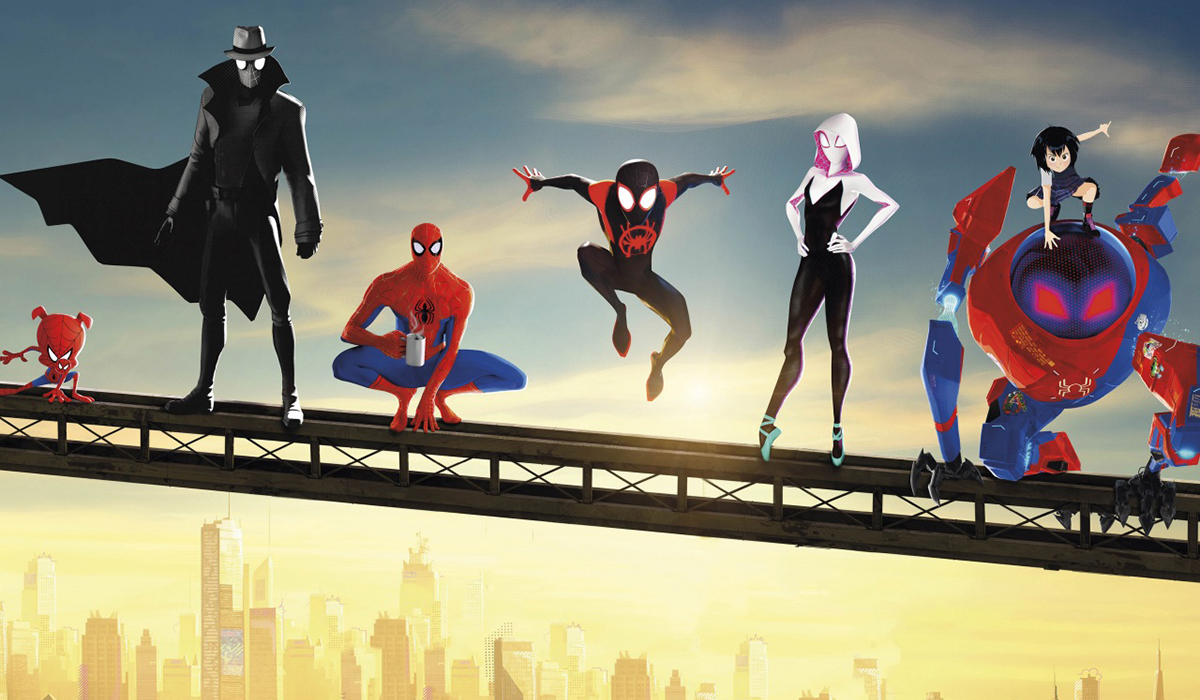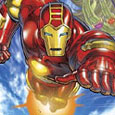Mainframe/Sony Pictures (2003), Columbia TriStar Home Entertainment (January 13, 2004), 2 discs, 219 mins plus supplements, 1.78:1 anamorphic widescreen, DTS and Dolby Digital 5.1, Rated PGV (US), G (Canada), Retail: $24.95
Storyboard:
Peter Parker faces an array of challenges in both his personal life as well as when he fights crime as Spider-Man, in a modern CGI series.
The Sweatbox Review:
One might think that it would be difficult to screw up a great character when adapting it to the screen, but many have done just this in the past. Think Batman and Robin. Think Superman IV: The Quest For Peace. Think Nicholas Hammond starring in The Amazing Spider-Man. Come to think of it, many well-meaning people have messed up comic book adaptations over the past few decades, so it must be harder than it looks. It’s always nifty, then, when someone gets it right. Such is the case with MTV’s new Spider-Man series, now available on DVD.
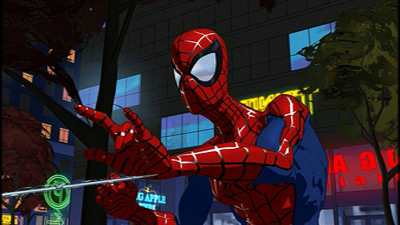
Spider-Man, as many readers will know, appeared in Amazing Fantasy #15 way back in the early 1960’s. It was expected to be his only appearance, given that it was the final issue of the comic book, and the publisher was not too impressed by the idea of a nerdy teenage kid acting like an arachnid; but Stan Lee’s script and Steve Ditko’s artwork struck a chord with readers, and this underdog hero became one of the most popular superheroes in comics. He has since had several animated series, a live action series, and a major live action feature, which has all led into the newest version— a version which is at once recognizably our favorite hero but also unlike any version seen before.
It was the expected success of Sony’s 2002 Spidey feature film that was the impetus for creating the animated series. Sony saw that a new cartoon, debuting relatively soon after the movie was released, would likely be a great success. They wisely figured that it would be best to distinguish the show from any other animated version, however, as there had been dozens and dozens of episodes from many prior series, basically from every decade since the character was created. Sony wanted a fresh approach, and put the word out: They wanted a new look, using new technology.

Yes, Spider-Man: The New Animated Series would be computer-animated; but not with a 3-D look. It was decided to use a 2-D look, while still taking advantage of what computer graphics had to offer— unique and complex shading and staging. CGI had been used in the 1990’s on a Spider-Man show, but it was an awkward and jarring blend of a traditionally animated Spidey against backgrounds that constantly changed from painted to computer-drawn. The new show would use a wholly consistent look, with the idea that it would look like a comic book that moved.
Mainframe, the Vancouver studio behind Reboot, won the contract with a terrific presentation film that showed they could deliver the action and detail that the series needed. Still, Sony and MTV worked with them to develop a flatter look that would look more graphic and less like what people expected from CGI cartoons. The result was a success for the most part. Still images from the series look like they could have come directly out of a modern comic, albeit one that was drawn with a very clean line. Watching the show, however, the viewer can appreciate the ability of the medium to portray the Spider-Man character in particular in a dynamic way that had never been seen before in his cartoons. The design elements were still influenced heavily from the comics, with cited artistic influences including the John Romitas (Senior and Junior), Mark Bagley, and Todd McFarlane.
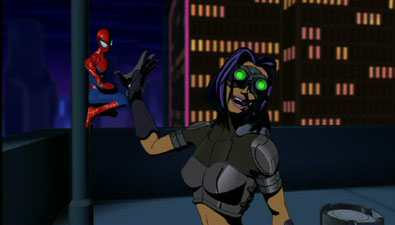
The look of the show has been described as “neon noir”, and if it seems like an oxymoron, then you will understand once you watch the show. Bright colors are contrasted against solid black shadows, not unlike much comic art.
There are some drawbacks to using CGI, however. As each tiny movement must be given a computer instruction, there is a certain amount of fluidity lost. Hair floats as if sculpted with gel, and body movements sometimes look stiff. This is not because of a lack of animator talent, though, but more a product of lacking time. The grind of producing an animated TV show means taking shortcuts, but overall the characters do move surprisingly realistically. The main characters have a subtlety of performance that is very impressive most of the time. This show was 70% key-framed, as opposed to motion captured. This means that the animators relied purely on their own skill the majority of the time; only extremely complex movements (like martial arts), or background characters were motion captured to save time. One interesting side effect of the 3-D process is that sometimes the computer seems unsure of whether to draw something, especially the line of a nose or wrinkle on a face, causing a blinking effect that is mildly distracting.
The backgrounds suffer at times, too. The far backgrounds are painted, but foreground elements and near backgrounds are computer generated. Again probably due to both stylistic choices and time constraints, the buildings often lack detail and look too simplistic. Of course, highly detailed backgrounds would have taken too much computer rendering time, so this is understandable. I also felt that New York was under-populated; as much as they tried to get lots of background characters in the shots, the streets are still far from crowded with people. Again, this was an issue with rendering time. The budget also necessitated using a small cast, so the series has a heavy focus on the three main characters, and Harry and Mary Jane spend too much time as hostages.
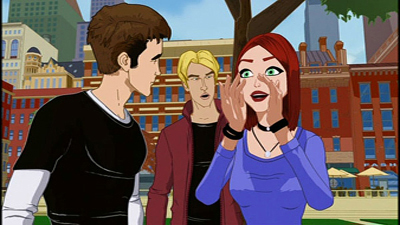
I am picking nits, though. Overall, especially considering the restraints of the medium, I really enjoyed the look of the show and found the animation top-notch. The writing is also sharp— hip without obviously trying to be hip. The relationship between Peter and MJ is especially interesting, and references to James Bond, Batman, the X-Men, and Winona Ryder are freely used. The writers and animators are also creative in how Spidey uses his powers, and it is neat to see Peter using his webbing in natural ways even when out of costume. The reflective webbing on the costume really makes the character come to life in a dynamic way. The animators are also skilled at depicting the dichotomy of Peter and Spider-Man. Peter is only confident when he wears the mask, and it is reflected in the posture and body language of the animation.
As this was developed as a movie tie-in to an extent, the producers of the show generally follow the premise of the movie version of the character, or approximately the 1970’s comic book version updated for the 21st century (including the movie’s organic web shooters, rather than the mechanical ones I loved in the comics and older TV shows). Peter Parker is attending Empire State University in New York. His best friend and roommate is rich kid Harry Osborn, who hates Spider-Man since he thinks that Spidey murdered his dad (who was actually The Green Goblin). Peter’s childhood crush, Mary Jane, is also in university with them, harboring feelings for Peter that he is reluctant to feel himself. The cast includes Neil Patrick “Doogie” Harris (I know he’s done other things in the past ten years or so, but he will always be Doogie Howser to me) as Spidey/Peter Parker, Ian Ziering (Beverly Hills 90210) as Harry Osborn, and singer Lisa Loeb as Mary Jane Watson. Other voices on the show, whether as guests or recurring characters, include Ed Asner, Rob Zombie, Eve, Gina Gershon, Kathy Griffin, Michael Clarke Duncan, and Spidey creator Stan Lee.
Notably, Peter’s Aunt May is absent, except for appearing in a photograph in one episode. I think that emotionally, this is what makes this show different from any other versions. Even if I found Aunt May annoying sometimes in the other cartoons, she was always a tremendously important presence in Peter’s life. Obviously this show, skewing to a Gen X/Y demographic, jettisoned her from having an active presence, so that it could focus on the young trio of friends. The other effect of being on MTV is that the show sports a PGV rating (although only a “G” in the Canadian content rating), with more than the usual amount of strong language, implied sex, and death than is normally allowed in superhero TV cartoons. This is far from overdone, though, and is no worse than what appears in today’s comic books that are aimed at teens and twenty- or thirty-somethings.
One advantage that the show carries over the movie version is in its ability to show expressiveness in Spidey’s eyes. It may not be realistic to show eyes on a mask going wide or squinting, but it sure is helpful in conveying emotion. Spidey fans will also enjoy some genuinely witty banter, reflective of the comics but not always captured so well in previous cartoon shows.
The 2-disc DVD set includes all 13 episodes (21 to 22-minutes each) of what is hoped to be only the first season, as well as copious extras.
Disc 1
Heroes And Villains – A youth with a repulsion-attraction suit, dubbed Turbo Jet, plays Robin Hood, and runs afoul with the law— not to mention Spidey. I couldn’t help but think of cheesy 1970’s Spidey villain “Rocket Racer” while watching this one, although no one on the audio commentary admitted to it.
Royal Scam – Spidey is lured via a helicopter chase by “Feds” and asked to collect a new computer chip that can decrypt banking satellite signals. The Kingpin is the big villain here, sporting the complexion and voice of The Kingpin from the Daredevil movie, but with the bulk of the comics version.
Law Of The Jungle – J. Jonah Jameson, publisher of The Daily Bugle, finally appears in this collection, and The Lizard is introduced. Harry questions his hatred of Spider-Man when he sees Spidey behave heroically. The lizard is s-c-a-r-y in this show!
Sword Of Shikata – A rare animal collector hires a mercenary to capture Spider-Man. In this episode and others, we see that the police are not friendly towards Spider-Man, and the feelings of New Yorkers are mixed.
Keeping Secrets – A character inspired by the comic book character of The Black Cat becomes involved with Harry. Peter struggles over how to convince her to quit her life of crime before she hurts his best friend. By this episode, I began to realize that there were sure an awful lot of helicopters in this show! Spidey also used a webbing to gum up car axles quite often in the first few episodes on the disc, which thankfully became less frequent later on.
Tight Squeeze – This is a good twist on the old plot standby of the hero being in a hostage situation while the villains wait for his masked alter ego to show up. The bad guys here are former KGB agents with power suits. Finally, neither Harry nor MJ are hostages this time around! This episode is important for introducing an important new character that serves as a love interest for Peter.
Head Over Heels – Spidey gets a stalker who thinks that they are soul mates. This is a problem since she also has weapons and threatens MJ.
The Party – This was the first episode produced, and was written by series Executive Co-Producer Brian Michael Bendis. Bendis also writes the comic book Ultimate Spider-Man, which is another attempt to make a younger Spider-Man contemporary. He was invited to help develop the TV series since the other producers were appreciative of the “vibe” that Bendis had in his comic. This story introduces a drastically new version of classic villain Electro, who is this time a university acquaintance of Peter, and even more of an outcast.

Disc 2
Flash Memory – Flash Thompson, Peter’s old high school nemesis, is introduced in this show. He is still a fan of Spider-Man, but endangers Spidey after getting involved with experiments to boost his brainpower. Jeffrey Combs acts all Re-Animator-like in a guest shot as a mad scientist.
Spider-Man Dis-Sabled – Spider-Man is the quintessential New York City superhero, but I love it when he gets mixed up in bigger affairs that he cannot understand. Assassin Silver Sable seems to be out to kill the Mayor, yet the more Spidey learns, the less sure he is of what he should do.
When Sparks Fly – Electro re-emerges to threaten a girl on campus. AND Peter gets something he never seemed to get in the comics. I was thinking, “Isn’t he supposed to be more of a loser?”
Mind Games – Part One – Peter (and Spidey), affected by telepathic twins, becomes more cavalier. And Kraven the Hunter is “back”. Actually, we haven’t seen him before, but apparently Peter has been Spider-Man for a while already and sent Kraven to the stalag years ago.
Mind Games – Part Two – I was looking for more tragedy in Peter’s life, and here it is. Oh, man. This gut-wrenching episode confirms that the creators know Spider-Man. Peter can only be happy if something bad is around the corner. I was sucker-punched, but have to agree with Stan Lee’s audio commentary on this episode: What a great way to end Season One! …But now there had better be a Season 2!!!
Is This Thing Loaded?
If you were not impressed yet, you will be after checking out this list of extras. These discs are stuffed with goodies.
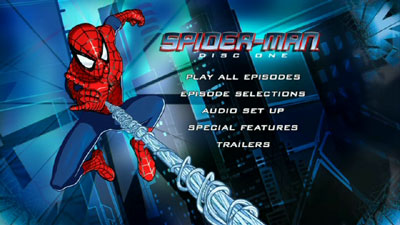
Each episode comes with an Audio Commentary track. The participants are varied, but always led by co-executive producer Audu Paden. The commentaries focus on all aspects of the production, depending on the participants, giving a tremendous look at how the show was made. Participants include writers, animators, producers, executives, voice artist Neil Patrick Harris, and creator Stan Lee. They do comment on the on-screen action, but also delve wonderfully into the nuts and bolts of producing the show, from pre-movie inception to post-production. The commentaries alone are a fairly complete archive of how the show was made. But there’s more…!
Just in case anything is missed during the commentaries, there is also Amazing Spider-Facts on a subtitle track. These pop up in boxes on-screen, and tend to point out specifics of what is happening on screen at the time, or to reference the comic books.
Disc One also has Production Artwork, Filmographies, and Trailers for various live action and anime films.
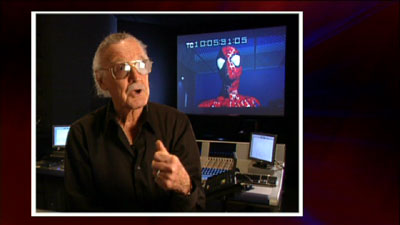
If you favor video-based documentaries, then there is plenty of meat on Disc 2 for you. When you choose Featurettes from the Special Features menu, you will be brought to a menu with several choices, totaling about an hour of material. The Making Of Spider-Man (23:21) is a good overview of the show’s production. Speakers include Paden, Lee, and Harris. Like the other featurettes, this one is based on thoughtful on-screen speakers, rather than fluffy voice-overs. It also has looks at artwork and computer use. The rest of the featurettes look more specifically at animating the show and its music. Spider-Man Tech: Creating The Models (12:34) examines the difficulty of creating a 2D look with an inherently 3D process, the choice of using “ink lines” to outline the characters, and shading the models. Spider-Man Tech: Animating Performance (13:40) looks at how acting is achieved via the animation and inspired by voice performances, key framing vs. motion capture, lighting, and the computer animation process in general. Spider-Man Music: The Composers (7:03) has two of the composers speaking about scoring the show.
There is also an Outtake Reel (1:34), an amusing tidbit similar to the outtake spoofs seen with the Pixar films. Building With Layers is a 29-second loop with 5 viewing angles showcasing various layers within a single scene. The Initial Mainframe Pitch (1:09) is what got the studio its contract, and shows an equally skillful but more 3D take on Spider-Man. The Abandoned “Spidey-Sense” Test is simply a black and white representation of a short scene. Finally, Rough Animation (1:40) is an example of a scene prior to final rendering.
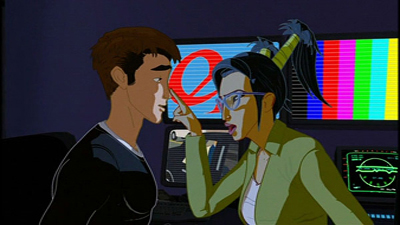
DVD ROM: And one more feature! If you have a PC with a DVD drive, then you can use Disc One’s Character Modeler. This is an HTML document that shows you the 12 different “heads” used in the series, and how each one can be changed with the addition of certain features to make a new individual. Pretty neat. There are also some Web links to Sony/Columbia Tri-Star sites.
Case Study:
Keepcase with tray and inserts.
Ink And Paint:
Practically perfect. The colors are super-vibrant, and outlines are sharp without any halo effects. My only complaint would be the aliasing type of effect seen as the virtual camera pans diagonally across backgrounds… and this isn’t even likely the fault of the transfer, but an effect of the scene rendering. Still, it’s not perfect, regardless of the source of the problem. But, darn it does look nice overall!
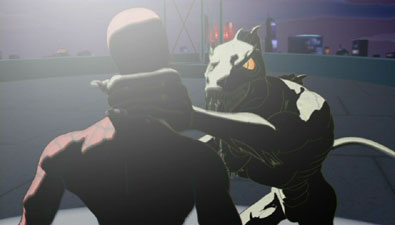
The image is 16:9 anamorphic. This aspect ratio was how the series was produced, which can be easily seen while watching the supplemental materials.
Scratch Tracks:
Now this is impressive. Sony sprang for a 5.1 mix for this show, and offers it in Dolby Digital and DTS versions. Regardless of which one you choose, the sound field is full, and boisterous when it needs to be. Every facet of the audio is crisp, and the rock-inspired soundtrack (slightly techno) truly is reproduced to its best advantage. The attention to detail on this show is great, too. I cannot remember ever hearing Spidey scurrying on the side of a building like you can hear on this show. There is a surprising amount of rear speaker activity, too.

Final Cut:
This was an early contender for a “Best of 2004” list. The show itself is a faithful but updated version of a classic character, presented in what is essentially a brand new medium that strikingly blends 2D and 3D sensibilities. The video and audio quality are terrific, and the bonus materials are not only plentiful but also substantial and interesting. There are so many good reasons to buy this disc, so long as you appreciate the look of the show and what has been done with the characters.
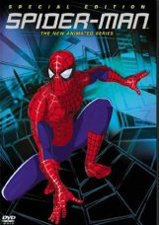 | ||
 |







